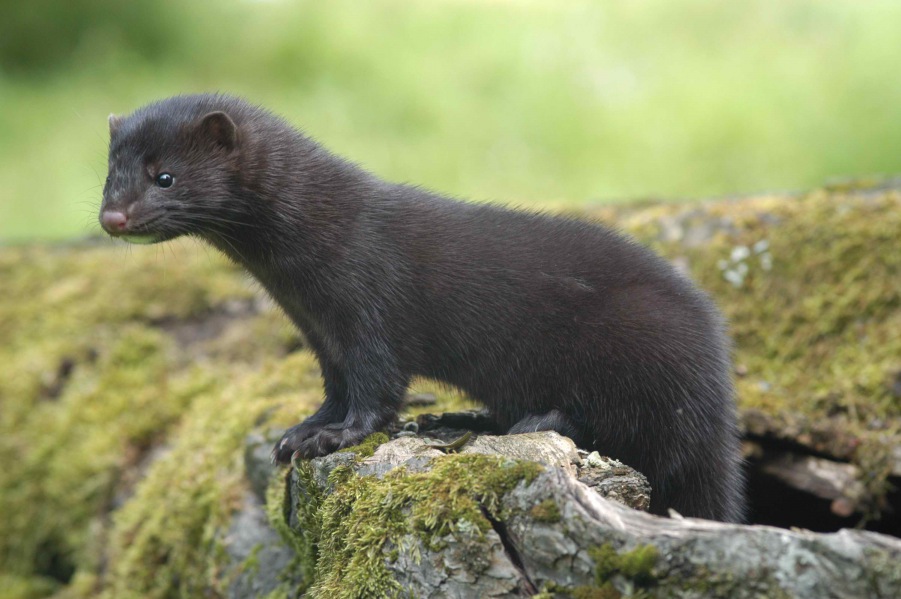
American mink(Mustela vison or Neovison vison)
Phylum —chordata
Class — mammalia
Order — carnivora
Family — mustelidae
Genus – neovison
Appearance
The American mink differs from members of the genus Mustela (stoats and weasels) by its larger size and stouter form, which closely approach those of martens. The American mink is similar in build to the European mink, but the tail is longer (constituting 38–51% of its body length). The American mink has a long body, which allows the species to enter the burrows of prey. Its streamlined shape helps it to reduce water resistance whilst swimming.
Males measure 13–18 in (34–45 cm) in body length, while females measure 12–15 in (31–37.5 cm). The tail measures 6–10 inches (15.6–24.7 cm) in males and 6–8 in (14.8–21.5 cm) in females. Weights vary with sex and season, with males being heavier than females. In winter, males weigh 1–3 lb (500–1,580 g) and females 1–2 lb (400–780 g).
The American mink's winter fur is denser, longer, softer, and more close-fitting than that of the European mink. The winter fur's tone is generally very dark blackish-tawny to light-tawny. Colour is evenly distributed over all the body, with the under side being only slightly lighter than the back. The guard hairs are bright and dark-tawny, often approaching black on the spine. The underfur on the back is very wavy and greyish-tawny with a bluish tint. The tail is darker than the trunk and sometimes becomes pure black on the tip. The chin and lower lip are white. The summer fur is generally shorter, sparser and duller than the winter fur. It moults twice a year, during spring and autumn. It does not turn white in winter.
Habitat
This species is native to North America, and it is found from Alaska and Canada southwards through most parts of the United States, aside from dry parts in the southwest. It was also introduced to many areas in Europe and South America.
Behavior
American minks are mostly solitary animals, males being especially intolerant of each other. They mark their home range boundaries using musky secretions from their enlarged anal glands. These animals are nocturnal, they are mostly active during the night, especially close to both dawn and dusk. They are also skilled climbers and swimmers. When searching for food, they are able to swim to depths of 30 meters (100 feet) and dive as far as 5 meters. They dig burrows in riverbanks, lakes and streams, or use old dens where other mammals have lived, such as muskrats. Sometimes they line their den with dried leaves and grass, and fur from prey. American minks will communicate with a range of cues, including visual, chemical and auditory signals. These animals are fairly quiet, but they rely heavily on chemical signals for communicating territorial boundaries, as well as reproductive status.
Diet
American minks are carnivores. The diet of these animals changes with the season. During summer they eat small frogs and crayfish, as well as small mammals like shrews, rabbits, muskrats and mice. They sometimes eat ducks and other water birds, as well as fish. In winter, they mostly eat mammals.
Reproduction
American minks are polygynandrous, with both males and females mating with multiple partners. The mating season runs from February in the south to April in the northern part of the range. Gestation is for 40 to 75 days. Young are born in April or May (late spring), and litter sizes usually range from 1 to 8 kits. Their eyes open when they are three and a half weeks old and weaning takes place when they are a month and a half old. They remain with their mother until fall, when they go off to establish a territory of their own. They begin mating when ten months old.
The maximum lifespan of a mink is usually around ten years, but rarely exceeds three years in the wild.
In captivity
We recommend that only experienced exotic animal owners consider purchasing a mink as they can be dangerous and cause injury.
It’s incredibly important that a veterinarian capable of caring for mink be found before deciding to keep one. Mink will need a killed vaccine of distemper and rabies and yearly boosters.
A captive kept mink should be provided with a high protein and low carbohydrate diet. This can mean a high quality, high protein ferret or cat food or a raw protein diet. Raw protein diets can sometimes be incomplete and run the risk of spreading bacteria to the animal and humans. Providing (killed) whole prey can offer enrichment and essential nutrients for mink.As with any animal, you should always provide mink with clean drinking water at all times.
With their high energy and drive to hunt, minks require adequate space to play and stimulation to keep them happy. A multi-level ferret cage might be acceptable at a young age, but activity outside that space will be necessary. Like any animal, the larger the enclosure and activities similar to their life in the wild that you can provide, the more content your mink will be. Minks are semi aquatic, they have webbed feet to assist in swimming, and providing them with access to water to swim in is an excellent form of enrichment. Minks are skilled escape artists and this should be kept in mind when planning housing.
As minks are natural predators capable of killing animals larger than themselves, they should not be trusted to have contact with small household pets (including but not limited to- fish, small rodents, rabbits, cats and small dogs).
 Russian
Russian
 English
English























